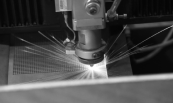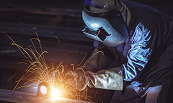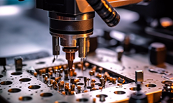0.1 Fundamentals of Laser Cutting
What is Laser Cutting?
Welcome to the first lesson of Laser Cutting University. Whether you’re a business owner, engineer, or workshop professional, understanding laser cutting is key to leveraging modern fabrication technology. In this beginner-friendly guide, we’ll define what laser cutting is, trace a brief history of how it evolved, explain how laser cutting works, and outline the basic types of laser cutting machines and their advantages. By the end, you’ll see why laser cutting machines have become indispensable in industrial manufacturing today.
Figure: A CNC laser cutting machine uses a focused laser beam to cut intricate shapes from sheet metal, producing a shower of sparks as the material is melted and blown away. Laser cutting is a technology that uses a concentrated, high-power beam of light (a laser) to slice through materials with extreme precision. Essentially, a laser cutting machine directs this intense laser beam through optical components and onto the workpiece, rapidly heating, melting, or vaporizing the material along a programmed path. Unlike mechanical cutting, the laser beam is non-contact – it’s like an invisible “blade” of light – so it imposes no physical force on the material. As the laser moves (or the material is moved) under CNC control, it can create very precise cuts with narrow kerfs (cut widths) and a high-quality edge finish.

Brief History and Evolution of Laser Cutting
Laser cutting might sound high-tech and modern, but its origins go back several decades. The first industrial laser cutting machine was introduced in 1965, when engineers used a focused laser to drill holes in diamond dies for making wire drawing tools. By 1967, researchers in the UK had pioneered the technique of laser-assisted oxygen jet cutting for metals – essentially using a laser beam in combination with an oxygen stream to cut through metal plates. In the early 1970s, laser cutting found its way into aerospace manufacturing, where lasers were used to cut titanium for jet aircraft parts. At that time, laser cutting (using carbon dioxide gas lasers) was developed for non-metal materials like textiles, because early lasers did not yet have enough power to cut through thick metals.
Over the ensuing decades, laser cutting technology advanced rapidly. Higher-power laser cutting machines became a staple in sheet metal fabrication from the 1980s onward. By the 1990s, a new generation of solid-state lasers known as fiber lasers began to emerge for industrial use. (Fiber laser technology was first invented in the 1960s, but only became commercially viable in the 1990s as engineers learned to amplify laser light through fiber-optic cables.) Fast forward to today, and fiber laser cutters have largely revolutionized industrial laser cutting – with some systems boasting laser powers of 10–30 kW, capable of cutting thick steel plates at remarkable speeds. For example, Laser Technologies India’s GH Series fiber laser cutting machines offer lasers from 3,000 W up to 30,000 W and can move the cutting head at speeds up to 200 m/min for high-efficiency sheet metal laser cutting. This evolution from the first laser in 1965 to modern CNC fiber laser cutters shows how far the technology has come in precision, power, and productivity..

How Laser Cutting Works?
Laser cutting works by focusing a high-energy beam of light onto a very small spot on the material to be cut. This focused laser beam rapidly heats the material to its melting point (or even vaporization point) at that spot. Here’s a simplified look at the process:
Focusing the Laser: The laser beam is generated by the laser source and then directed through lenses or mirrors that focus it to a tiny, intense point. Think of how a magnifying glass can focus sunlight to burn a hole in paper – a laser cutter does this with a far more powerful coherent light beam, creating a heat spot hot enough to melt metal. The focused beam can be as small as a fraction of a millimeter in diameter, concentrating tremendous energy.
Material Melting/Vaporization: As the laser beam hits the material, the extreme energy density causes the material to melt, burn, or vaporize in a localized area. For metals, the laser actually melts the metal; for organic materials like wood or plastics, it may burn through them. In some cases, the laser energy completely vaporizes the material into fumes. This process creates a slit or cut kerf through the thickness of the workpiece.
Assist Gas: Most industrial laser cutting also uses an assist gas jet aimed at the cut zone. Typically, high-pressure gas (often oxygen or nitrogen) is blown coaxially with the laser beam. The gas has two roles: first, it blows away the molten material from the cut, clearing the path; second, for certain materials like steel, an oxygen assist gas can react with the hot metal to accelerate cutting (essentially behaving like a torch by adding heat via oxidation). If cutting stainless steel or non-metals where oxidation is unwanted, an inert gas like nitrogen is used to simply purge molten debris and keep the cut clean. The result is a smooth, dross-free edge.
CNC Motion Control: A computer numerical control (CNC) system moves the laser cutting head (or occasionally the workpiece table) in accordance with a pre-programmed design. The cutting path is usually programmed via a CAD/CAM software that outputs a G-code file – essentially a set of coordinates and commands that tell the machine how to move the laser beam along the X and Y axes. This way, the laser cutter can carve out intricate profiles, sharp corners, and even fine details that would be difficult with a conventional saw or punch. Because the laser beam can change direction instantly and there’s no physical blade to bind or wear out, unlimited 2D cutting complexity is possible.
Laser cutting machine acts like a highly precise, heat-based "knife". It draws the pattern on the material with the laser, and the material is separated as the beam passes. The combination of intense focused heat, assist gas, and CNC-guided motion enables laser cutters to produce clean, accurate cuts at high speed. For instance, a fiber laser cutter can cut through thin sheet metal much more quickly than a mechanical cutter because tool friction does not affect how quickly the beam and heat can move. Software controls the entire process, making it repeatable and simple to switch between various part designs—just load a new programme and cut. This is a key reason why industrial laser cutting is so popular today: it’s an automated, precise, and flexible way to cut materials.:







